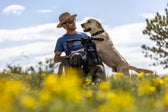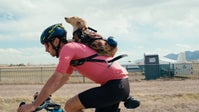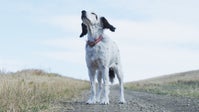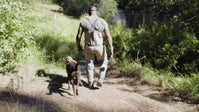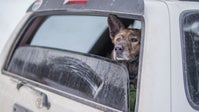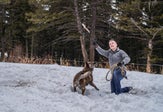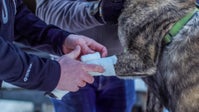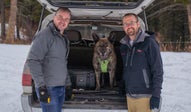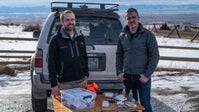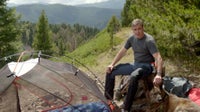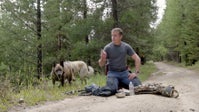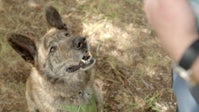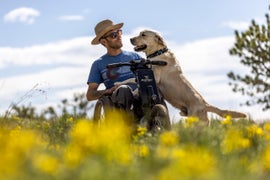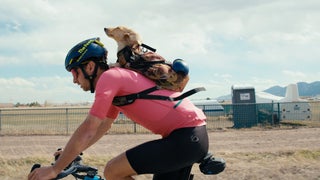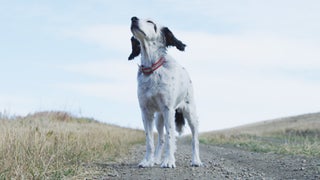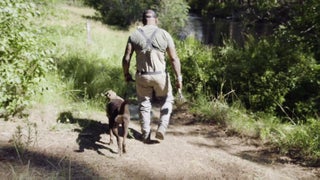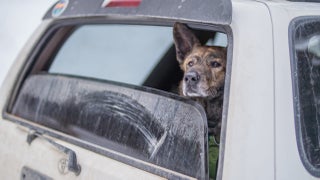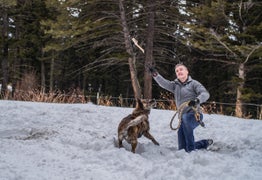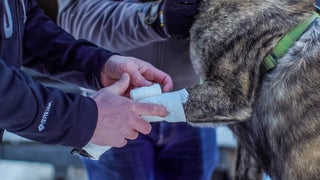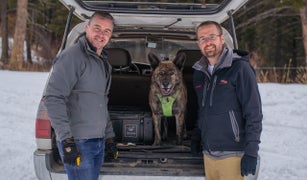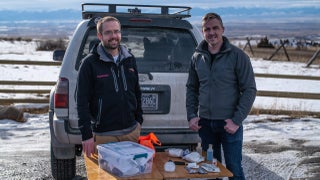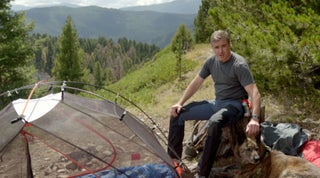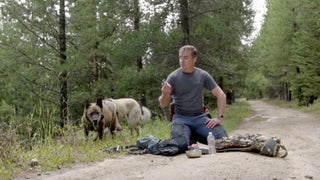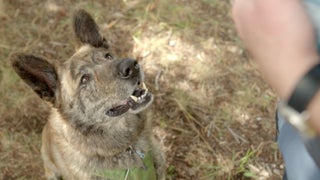[MUSIC PLAYING] WES SILER: Today, we're going to be talking about dog first aid. And to help with that I've got Joe Poo in town from Sioux Falls. And he is a sporting dog specialist veterinarian.
[MUSIC PLAYING]
[HOWLING]
How's it going, Joe?
JOE SPOO: Good, glad to be here in beautiful Bozeman.
WES SILER: Yeah. So we got Wiley here, and Wiley has just come back from a nice big hiking trip. So how do we make sure that he is not injured? Or if he is injured, what do we do about that?
JOE SPOO: So two things I recommend for people is to do a tailgate exam when you get back to the vehicle, and make sure there's nothing major or hidden with the dogs. And then if there is, have the appropriate first aid kit to be able to address the problems if you do find a problem. And so tailgate exam starts as a dog's walking back. Is it the same dog you started the day with?
Is he bright and alert? Is he just tired, or does he have a problem? Is he carrying is his back differently? Is he favoring a leg? Does he seem depressed, or is he tired?
And so as that dog's coming back off the trail, taking a look and see is it the same dog we started with, and he's just tired from the hike? And then get your hands on the dog. And so the big thing is to start at the tail and work to the end of the dog and see if we got problems. So if you've been in tall grass or things where the dog's been poking around, I like to look in the nostrils and make sure that we don't have anything stuck up the nose.
Some of these guys will come back, and they'll be sneezing. And it's important to determine, are they sneezing because it was dry and dusty out? Or did they get something up there? What you'll notice with that will be, is there discharge out one side and not the other? Then I'd worry there's something up the nose.
And then start with the eyes. Are they equal? And so dogs are really good at getting little seeds or things stuck in those eyes. And so rolling down that eyelid and looking in that third eyelid. So they have a little windshield wiper that comes across the eye.
And make sure that there's not debris down in there. If there is, get it out because where we'll have problems with the eye is if they get a seed or a bit of dust or dirt in there, and it's constantly rubbing the eye. Then we'll get an ulcer on the surface of the eye. So making sure that those eyes are equal and they're not squinting or favoring one.
You're looking in the ears, making sure that we don't have anything in the ears. And then start at the toes. And so obviously, this is where the rubber meets the road with these guys.
And so making sure that we don't have any injuries within the paw pads or the paw pads themselves, checking out the nails to make sure there's no broken nails, and then just kind of feeling. Do the joints work like they're supposed to? Does he react to any of the movements of the joints? And do that for all four of the legs.
And then the big thing too with these dogs that are out in heavy cover, or if there's fences around, is looking for cuts in places that they can really flay themselves open. And the most common places for that are going to be up in the armpits. So the big thing is with a dog like this with a thick fur is to be able to look and see where the common areas will have hidden wounds.
Where we'll see it is you get home with the dog. And everybody's relaxing, or a day later, he rolls over for some belly rubs. And we see that there's this huge cut up in his armpit or in the groin.
And so it's much easier to deal with if it's fresh and it just happened. We get those edges back together, versus if you bring him in to me two days later, it becomes a process. We're going to have to freshen things up, put him under anesthesia, and probably a longer recovery time as well.
WES SILER: Got ya.
JOE SPOO: And then same sort of thing. Feel along his chest. So the other problem that we'll sometimes see with these dogs, especially in timbered areas, is that if he's a hard charging running dog, is that they'll run into sticks and jam sticks into their body.
And so making sure that we don't have anything going on with the chest, and then feeling his belly as well and just making sure that we don't have any discomfort, any pain with his belly. And then again, feeling the back legs like you did the front. And very quickly, we've gone from tip of his nose to his rear feet to make sure that we don't have any issues when we've gotten off the trail.
WES SILER: And in terms of addressing those issues, what are some of the main priorities? Is it the same as like a human? Stop bleeding, that kind of thing?
JOE SPOO: Very much so. And we'll talk about the first aid kit, but I find that most people kind of fall into two categories-- the people that come without a thing being prepared, and so they kind of rely on prayer, and hopefully there's a vet clinic close by, or the people that think that they're EMTs, and they'll have a first aid kit that will fill an ambulance. And then they don't know what they can address, or they get over their skis a little bit. And so the big thing is that-- knowing what you can address, how to address it.
WES SILER: So that's a good practical tip, and what you can do every day to ensure your dog's safety. And then we're going to look at the materials you can carry to address a problem if you do find one.
